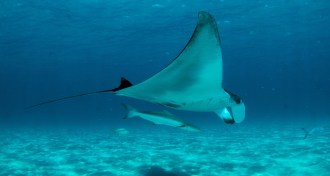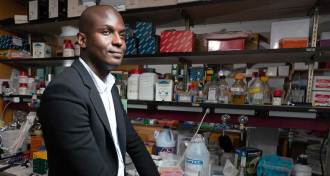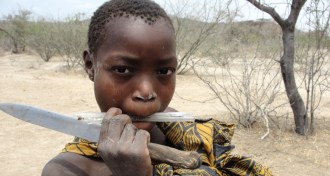Life
Sign up for our newsletter
We summarize the week's scientific breakthroughs every Thursday.
-
 Neuroscience
NeuroscienceSurvey raises worries about how screen time affects kids’ brains
A large study of U.S. children ties lots of screen time to lower thinking skills, but the relationship between the two is still unclear.
-
 Animals
AnimalsManta rays have an unusual mouth filter that resists clogging
Manta rays filter feed differently than other ocean creatures.
-
 Animals
AnimalsA new species of high-altitude hummingbird may already be in trouble
Researchers have discovered a new species of hummingbird high up in the Ecuadorian Andes.
-
 Life
LifeEmily Balskus uses chemical logic to study the microbiome
Using chemistry to peer at the microbial world, Emily Balskus is revealing how microbes influence human health.
-
 Genetics
GeneticsIbrahim Cissé unlocks cells’ secrets using physics
Biophysicist Ibrahim Cissé finds clues in raindrops and morning dew about how genes are activated.
-
 Health & Medicine
Health & MedicineLisa Manning describes the physics of how cells move
Physicist Lisa Manning probes how physical forces influence cell behavior in asthma and other conditions.
-
 Animals
AnimalsJenny Tung wants to know how social stresses mess with genes
Evolutionary anthropologist Jenny Tung is untangling the many health effects of life as a social animal.
By Susan Milius -
 Animals
AnimalsThis new fish species displays a splash of highlighter hues
Researchers stumbled upon a new species of coral reef fish with spectacular coloration and a unique habitat.
-
 Neuroscience
NeuroscienceA paralyzed man makes great strides with spinal stimulation and rehab
Researchers find success at restoring movement to paralyzed legs, giving hope to people with paraplegia.
-
 Genetics
GeneticsIn lab tests, this gene drive wiped out a population of mosquitoes
For the first time, a gene drive caused a population crash of mosquitoes in a small-scale test.
-
 Animals
AnimalsHow math helps explain the delicate patterns of dragonfly wings
Scientists have found a mathematical explanation for the complex patterns on the wings of dragonflies and other insects.
-
 Anthropology
AnthropologyThe way hunter-gatherers share food shows how cooperation evolved
Camp customs override selfishness and generosity when foragers divvy up food, a study of East Africa’s Hazda hunter-gatherers shows.
By Bruce Bower